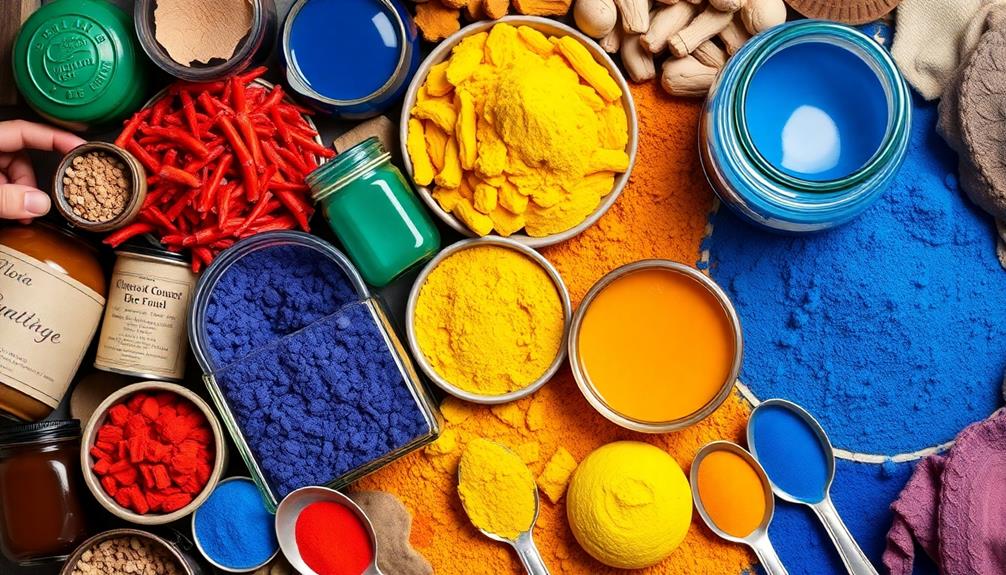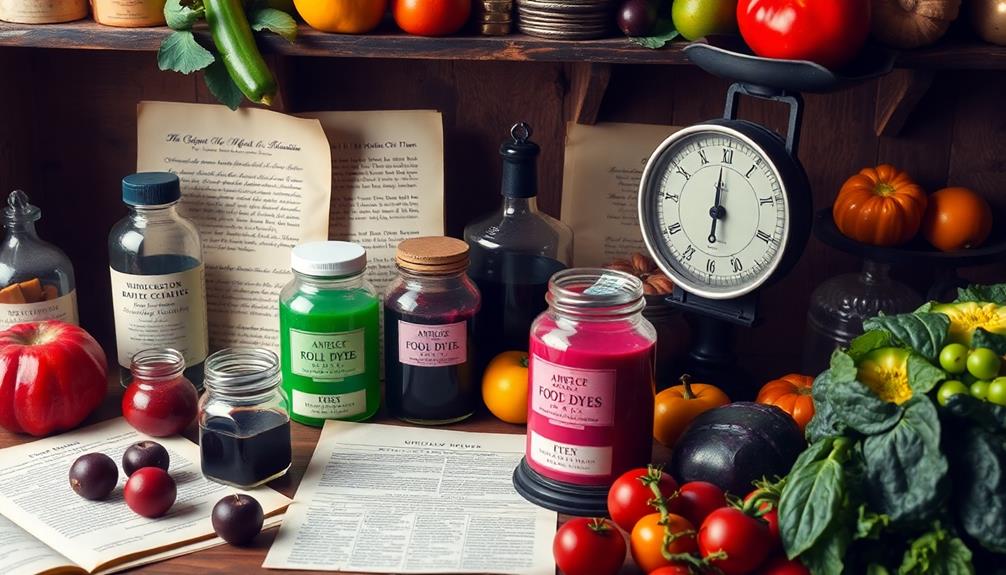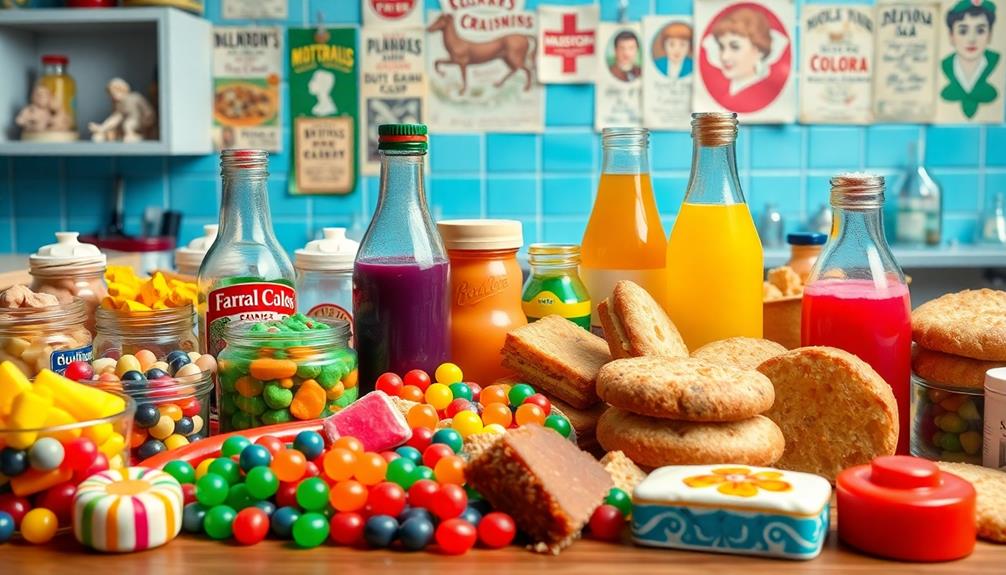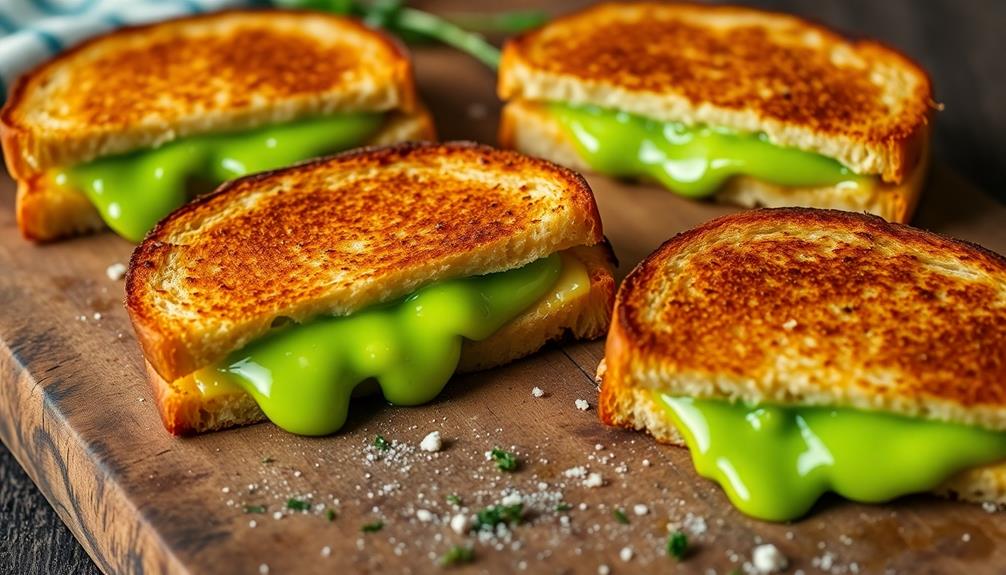You might be surprised to learn that artificial colors in food began in the mid-19th century with William Henry Perkin's mauve. As synthetic dyes gained popularity in the early 1900s, they transformed the food industry but raised health concerns, leading to legislation like the Pure Food and Drug Act of 1906. Since then, the FDA has approved only a handful of synthetic colorants due to ongoing safety debates. Today, there's a shift toward natural colorants as consumers prioritize health and transparency. To explore how this colorful journey continues to impact your food choices, you'll want to take a closer look.
Key Takeaways
- The journey of artificial colors began in 1856 with William Henry Perkin's discovery of mauve, marking the start of synthetic dye use in food.
- The popularity of synthetic dyes surged in the early 1900s, transforming food aesthetics and marketing strategies.
- Health concerns led to regulatory milestones, including the Pure Food and Drug Act of 1906, addressing the safety of food colorants.
- The 1960 Color Additive Amendments established a rigorous safety evaluation process by the FDA, approving only a limited number of synthetic color additives.
- Recent trends show a shift towards natural colorants, driven by consumer demand for transparency and perceived health benefits over synthetic options.
Evolution of Food Color Additives

As you explore the evolution of food color additives, you'll find that their journey began in the mid-19th century with the groundbreaking discovery of mauve by William Henry Perkin in 1856. This synthetic dye marked the birth of artificial coloring in the food industry, leading to the widespread use of synthetic dyes by the early 1900s.
Notably, just like the vibrant colors in dishes such as Sichuan Cold Noodles, this surge in popularity wasn't without consequences; health concerns arose, including reports of poisoning from certain dyes. In response, the Pure Food and Drug Act of 1906 was enacted to regulate food additives and endorse safe dyes.
By the 1960 Color Additive Amendments, the Food and Drug Administration (FDA) established a stringent safety evaluation process for color additives, ensuring new synthetic dyes could only be approved if proven safe for consumption. Despite this, the FDA has only approved seven synthetic color additives, while numerous others faced bans due to potential health risks, such as carcinogenicity and allergic reactions.
Today, you'll notice a growing consumer preference for natural food colorings, reflecting a significant shift in the food industry toward transparency and health-consciousness, steering away from synthetic options in favor of plant-based alternatives. This trend is driven by increasing awareness of the potential health risks associated with artificial additives and a desire for ingredient lists that are easy to understand. In the quest to create vivid, appealing hues using natural sources, food scientists are also exploring how cooking methods change proteins, which can impact both color retention and texture in certain foods. By leveraging advancements in technology and a deeper understanding of natural compounds, the industry is finding innovative ways to meet consumer demands for cleaner, more natural products.
Natural vs. Synthetic Colorants

The debate between natural and synthetic colorants continues to shape the food industry, with consumers increasingly leaning toward options that align with their health and safety concerns.
Natural colorants, derived from sources like carotenoids, chlorophyll, and anthocyanins, have a long history of use in food, much like the vibrant colors found in traditional Brazilian dishes such as Cuscuz Paulista, which showcases a variety of ingredients reflecting cultural influences.
In contrast, synthetic colorants, like FD&C Red No. 40 and FD&C Yellow No. 5, emerged in the late 19th century, altering food aesthetics and preservation techniques.
While the FDA has approved only a handful of synthetic colorants, their safety has been rigorously tested, leading to ongoing debates about potential health risks linked to artificial additives.
Natural options, such as cochineal extract, are often perceived as healthier alternatives, despite their potential to cause allergic reactions.
Consumer preference is shifting toward natural colorants, driven by a growing awareness of health implications and a demand for transparency in food ingredients.
Although synthetic dyes may offer longer shelf life and more stable properties, the food industry is responding to this trend.
Ultimately, your choices as a consumer are influencing the future of food coloring agents, pushing brands to reconsider their formulations.
Regulatory Milestones in Food Coloring

A significant evolution in food coloring regulation began in the 1880s when the USDA first authorized artificial coloring for butter and cheese. This marked the federal government's initial step towards guaranteeing the safety of color additives. The 1906 Food and Drugs Act further strengthened consumer safety by prohibiting poisonous colors in food and cosmetics.
In 1938, the Federal Food, Drug, and Cosmetic Act expanded upon this framework, mandating that all color additives must be deemed safe for consumption. The 1960 Color Additive Amendments introduced pre-market safety evaluations and the Delaney Clause, which prohibited any additives shown to cause cancer in humans or animals.
Today, as of 2023, the FDA has provisionally listed about 200 color additives for interim use, guaranteeing ongoing scrutiny and reassessment.
| Year | Milestone |
|---|---|
| 1880s | USDA authorizes artificial colors for butter and cheese |
| 1906 | Food and Drugs Act prohibits poisonous colors |
| 1938 | Federal Food, Drug, and Cosmetic Act guarantees safety |
| 1960 | Color Additive Amendments require pre-market evaluations |
These milestones reflect the ongoing commitment to safety in the use of synthetic dyes and artificial colors.
Health Implications of Color Additives

While many people enjoy colorful foods, the health implications of synthetic color additives can't be overlooked. Take FD&C Yellow No. 5, for example; this synthetic dye is linked to allergic reactions and potential behavioral issues in children.
Additionally, the vibrant colors seen in many cultural dishes, such as Yebeg Wat, may be enhanced using these additives, raising questions about their safety. You might find it troubling that ongoing research is exploring the broader effects of these additives on health and development.
Natural colorants, like cochineal extract, can also cause allergic reactions in some individuals, despite being generally recognized as safe. As consumers grow more cautious, there's a noticeable shift towards natural alternatives, reflecting a preference for transparency and safety in food products.
However, regulations surrounding synthetic color additives remain inconsistent. For instance, the FDA allows the use of certain dyes, despite their association with potential DNA mutations, while some countries have enacted stricter bans.
Additionally, additives like Citrus Red #2, used in oranges, highlight the health risks linked to synthetic dyes, especially since they're banned in organic products. As awareness of these health implications increases, it's clear that consumers demand more regulation and transparency regarding what goes into their food.
Future Trends in Food Coloring

Growing interest in food coloring is shifting toward natural alternatives as consumers prioritize health and sustainability. With increasing health concerns and a preference for transparency in ingredient sourcing, many people are turning away from synthetic dyes. Innovations in this field are also emerging, bringing exciting options to the table.
| Trend | Description |
|---|---|
| Natural Colorants | Derived from plant sources, these are gaining popularity. |
| Edible Spray Paints | Allow for creative and vibrant food presentations. |
| Pastel and Neon Hues | Consumers seek visually striking options. |
| Eco-Friendly Production | Companies focus on sustainable sourcing methods. |
| Stricter Regulations | Ongoing research may limit synthetic dye usage. |
As you explore food coloring options, you'll notice a rise in vibrant colors like pastels, neons, and metallics, enhancing your culinary experiences. Sustainability is now a critical factor in food production, leading to the development of eco-friendly colorants. The future is bright for food coloring, and it's leaning towards choices that are not just visually appealing but also align with a healthier, more sustainable lifestyle.
Frequently Asked Questions
When Did Artificial Food Coloring Start?
Artificial food coloring started in the mid-19th century. In 1856, William Henry Perkin discovered the first synthetic dye, mauve, which led to the widespread use of colorants in food by the early 1900s.
What Is an Interesting Fact About Food Coloring?
Food coloring fascinates, doesn't it? Did you know that in the early 1900s, manufacturers used toxic substances like lead and arsenic to enhance appearance? Thankfully, regulations now guarantee safer, more vibrant options for your meals. Today, food coloring not only adds visual appeal but also plays a role in branding and culinary creativity. Interestingly, it often intersects with the presentation of aphrodisiac foods in modern culture, where vibrant colors are used to entice and heighten the sensory experience. From red velvet desserts to golden-tinted cocktails, colors continue to captivate our appetites and imaginations.
Why Is Red 40 Not Banned in the US?
Red 40 isn't banned in the U.S. because the FDA's safety assessments confirm its safe consumption levels. Despite some concerns about hyperactivity links, there's insufficient evidence to justify its prohibition, ensuring its continued use in foods.
Why Are Artificial Colors Used in Food?
You'll find artificial colors in food because they enhance visual appeal, attract buyers, and create consistent product appearance. They also compensate for color loss during processing, ensuring your favorite snacks look fresh and appealing.
Conclusion
In the ever-evolving world of food coloring, you see that the journey from natural to synthetic additives reflects our changing tastes and health priorities. Just like a painter chooses the right hues for a masterpiece, you can be mindful of the colors in your food. As regulations tighten and consumers demand transparency, the future of food coloring is brightening. Staying informed will help you make choices that not only please your palate but also nurture your well-being.









